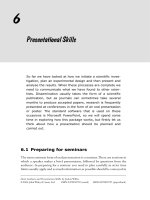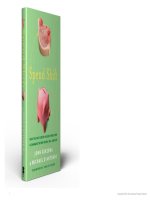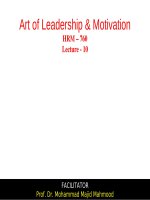Lecture Essay writing & presentation skills - Lecture 10: Narrative Essay
Bạn đang xem bản rút gọn của tài liệu. Xem và tải ngay bản đầy đủ của tài liệu tại đây (93.51 KB, 40 trang )
Lecture 10
Narrative Essay
Recap
•
How to Write a Critical Essay?
•
Steps for Writing an Critical Essay
•
Some Critical Styles
•
Key Points to Consider
•
Dos and Don’ts
•
Common Mistakes
•
Example
Narrative Essay
The narrative essay tells a story. It can
also be called a "short story."
–
Conversational in style
–
Tells of a personal experience
Examples: A narrative essay could tell of ...
* my brother's and my fishing trips;
* a boring trip to the grocery store;
* my near-death experience at the beach.
3
The Narrative Essay:
•
is told from a particular point of view
•
makes and supports a point
•
is filled with precise detail
•
uses vivid verbs and modifiers
•
•
uses conflict and sequence as does any
story
may use dialogue
•
Well Written Narrative
Essay
A well-written critical essay is one where
the writer has made a clear argument in
flawless language.
–
Logic
–
sound reasoning, and
–
an investigative attitude
are always seen by examiners as good
foundations for a well-organized discussion
about a set text.
How to Write a Narrative
Essay?
•
A narrative essay is type of essay writing
that is built around a narration of a
certain event or situation.
•
Basically, a narrative essay is a concise
form of a narrative novel.
•
Its main objective is to tell a story, so
that it is both engaging and interesting
How to Write a Narrative
Essay?
•
A narrative essay, more than any other
type of essay, allows you to be creative
as a writer. Nevertheless, there are certain
rules to follow and mistakes to avoid when
writing a narrative essay.
Steps for Writing a Narrative
Essay
Step # 1: Decide on a plot. You should never
start writing your narrative essay
before you come up with the plot for
it.
Step # 2: Do a sketch of events you plan to
depict in chronological order.
Steps for Writing a Narrative
Essay
Step
#
3:
introduction,
for the
When
starting
on
your
begin by setting the scene
situation you will narrate
about.
Here, it is best to go into details and
make the imagery as vivid and colorful
as possible, so that the readers will be
Steps for Writing a Narrative
Essay
Step # 4: As you go into the main body
paragraphs, narrate the story.
Try to develop the plot gradually,
starting from smaller events or
incidents that lead to the main scene.
Steps for Writing a Narrative
Essay
Step # 5: Write the main body paragraphs
in
accordance with the structure you
chose when making an outline –
Step # 6: Narrate the main scene of your
story. Use as many details and
emotional descriptions as you can to
portray the story in full. Draw the
reader
into the events by
evoking feelings
and describing
reactions of the
characters of your
story.
Steps for Writing a Narrative
Essay
Step # 7: End your story. Here you can
appeal
of
to the senses, moods and feelings
your characters, describing the
consequences of the narrated events.
Step # 8: Lay your work aside for some
time
and then do a thorough
proofreading.
Topic Selection
•
There are endless topic variations you can choose
from for your story.
•
With narrative being a very creative type of writing,
you have a unique opportunity to choose the ideal topic
to narrate about.
•
It should be something that you yourself find
interesting, otherwise it will be hard to make it
interesting for your readers.
Topic Selection
•
Your story can be true or fiction.
•
It can be narrated in the first or the third person.
•
Your narrative essay can be based on your own
experience, be completely imaginary, or describe the
experience of somebody you know.
•
It can be realistic or completely made up.
•
only basic requirement for a good narrative essay topic is
that it should sound interesting to appeal to the reader,
Topic Selection
Below are several examples of good topics for narrative essay.
However, keep in mind that the ideas to choose a good topic from are
limitless:
–
A mysterious book
–
One sleepless night
–
Our trip to the mountains
–
An unexpected occasion
–
Visiting the Castle of Dracula
–
A summer to remember
–
The most exciting moment of my life
–
Lost in the forest
–
A trip to never forget
Key Points to Consider
•
Genre of your writing:
Start your essay by deciding
upon the genre of your writing.
Only
after you make up your mind
about how
realistic
your
story
should
be
(depending on whether you want,
for
instance, to write a fantastic
science
fiction essay, or a realistic life
chronicle),
you can move on to
develop the
actual plot.
Key Points to Consider
•
If you find it hard to start your essay, or
cannot seem to come up with the story you
will convey, try to approach the process of
writing
with
a
“Question-and-answer
method”.
–
Start asking yourself basic questions about the
Key Points to Consider
•
With a narrative essay being a rather
informal type of essay writing, one thing
you should keep in mind is that even
though you are telling a story to your
readers, you are not exactly doing it the
way you would say it in person.
–
When
a
narrative
essay
is
too
Key Points to Consider
•
To experiment with your writing style and
make your narrative essay more unique,
you can use a literary technique called
‘flashback narration’.
•
You can start your story from a particular
point
in
time
(usually
something
Key Points to Consider
•
Try to express yourself more creatively
and figuratively.
–
Like, instead of just saying “a very old man
slowly entered the room”, you could say “a
grey-haired man with a thick beard opened
the door, his hands slightly trembling from
age, and heavily stepped inside”.
Key Points to Consider
•
With the narrative essay giving you certain
freedom to experiment with words, you
can use interesting and unusual word
combinations to make your writing more
creative.
–
A good example would be using action verbs
with inanimate objects, or ascribing animals,
Dos
•
Do use dialogues to make your writing
more vivid and life-like.
•
Do use author’s lines in between the
replicates your characters to add action
and help create a fuller picture of your
characters’ personalities, reactions and
Dos
•
Do give information in chronological
order. Use time words:
•
“first”
•
“before”
•
“then”
•
“after that”
•
“later”
•
“during”
Dos
•
Do enhance your writing with colorful
stylistic literary techniques, like:
–
Metaphors
–
Epithets
–
Distinguished comparisons
–
Bright Allegories and the like.
Dos
•
Do include detailed descriptions of the
places, people and buildings that are part
of the story. You should try to make it
easier
for
your
readers
to
picture
everything you describe in their mind.









